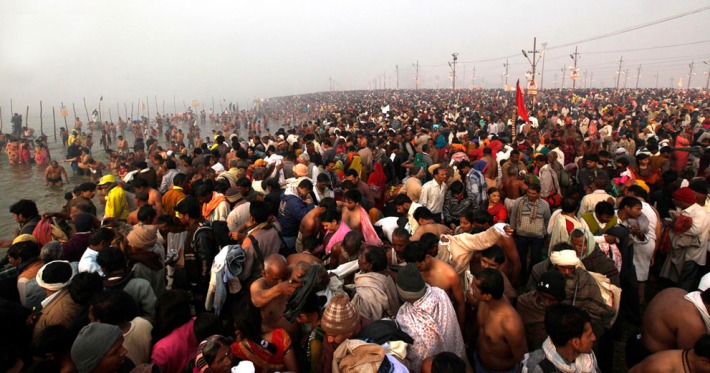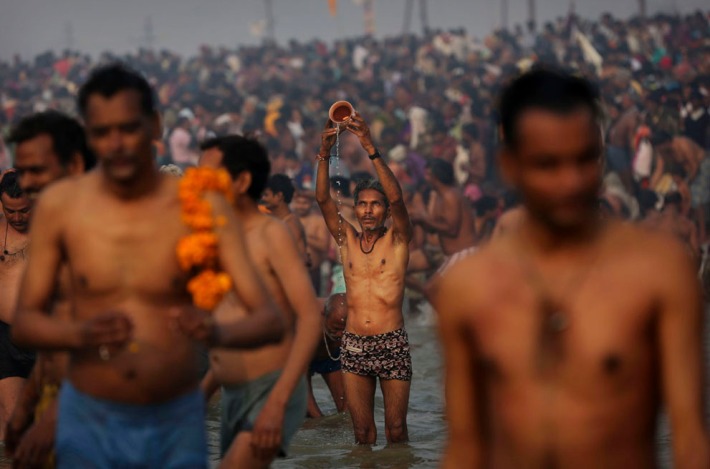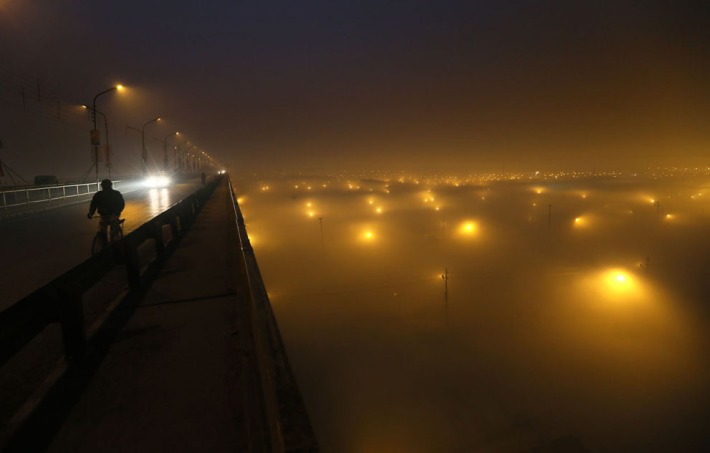Kumbh Mela, the biggest event of earth, is coming to a close so we’re here to digest some of the key points: gobbling up information and burping out questions, we thought long and hard about Kumbh Mela. In this post we’ll be answering three big questions: What is it? How does it happen? Can I go?
(AP Photo /Manish Swarup)
What is it?
You may have never even heard of Kumbh Mela, we wouldn’t be surprised. But in the last 53 days, up to 100 million people have descended upon the converging rivers of Allahabad. To put that in perspective the population of Germany is 81 million, whilst the United Kingdom has a mere 63 million inhabitants. It’s about 1.4% of the world’s total population. February 10th, the most auspicious bathing day, saw up to 30 million people descend upon the temporary settlement, making it for a split second the biggest municipality on the planet.
The Kumbh Mela happens roughly, very roughly, every 3 years, across four sites with sacred rivers passing through them (predominantly the Ganges). Every 12th year is the Maha Kumbh Mela, which happens only in Allahabad and is what we are looking at today. This also happens to be the 12th in a cycle of Maha Kumbh Melas: extra special. The general emphasis of the Kumbh Melas is that at this particular astrological moment, the Ganges is imbued with the power to wash away layers of Karmic debt. Its power comes from a moment when the gods fought over a pitcher of nectar, in that tumultuous instant a few drops fell down onto the current day sites of the Kumbh Melas.
So if you go down to the river today, you’re sure of a big surprise. Naked sadhus, 22, 500 street lights, and a whole load of tents. Down by the river dreadlocks abound, boats straddle the shoreline, and flocks of people tumble down the banks to bathe in the water. Backing up away from the river is nearly 2,000 hectares of land equipped with 156km of road, 12,461 police, and 80,000 kiloliters of drinking water. This has all been established in a matter of months preceding the festivities. No series of numbers will ever fully clarify the enormity of operations at Kumbh Mela, especially considering that aside from all the official government provisions the majority of the city has been organically developed by the pilgrims that have travelled from far and wide to be here.
(AP Photo/Kevin Frayer)
How does it happen?
Logistically speaking the Kumbh Mela of 2013 is a spectacle. Every aspect of life in a city exists here out of sheer necessity. It suffers and struggles with the same problems as any other mega-city: clean drinking water, law and order, and a good electrical supply, to name a few. This year is the first to be criss-crossed with cell phone towers as a critical mass of people now use cell phones. This has gone some way to solving one of Kumbh Mela’s more unique problems: lost and found.
Cameras, phones and money are petty items when compared to people and Kumbh Mela’s Khoya-Paya Shivirs (lost and found camps) work solely for housing and relocating lost relatives and friends. On Febuary 9th, the day before the biggest bathing event, 38,587 people went missing. Whilst the government provides some basic supplies, it is independent organisations that have grown up to help the misplaced. This year they have implemented a “What’s App” system, for smartphone devices, as well as nine LED screens around the site. The most significant method though is the one that has been used for decades, it’s moved from tin can speakerphones to tannoys but shouting the names of those lost from central points is still the most effective way to re-unite loved ones. This year the NY Times wrote a heartfelt story of the lost Mrs. Pandey and the helpful and generous Mr. Tiwari, but the situation is so common that it’s a recurring theme in Bollywood films. While technology is improving it remains the commitment and selflessness of individuals keeping the lost and found system semi-functioning.
People do not bring much to Kumbh Mela. It’s a festival of cleansing and worldly possessions are at a minimum. Despite this fact there’s still 200 tonnes of garbage to collect every day and the industry of maintaining the site is booming. Whilst the central government pumped in $220 million into this years Kumbh officials estimate 15 to 20 times that will be generated in jobs and business supporting the event. From security, to cleaners, to medics; over 100,000 people will be employed inside the festival grounds during the event. Time magazine interviewed Raj Mani, a garbage collector who was brought to a standstill on Sunday, February 10th, by the swarms of people. He said that he doesn’t make a profit on the festival, he does it out of love. “I’m working for the Mother Ganges,” he says. Although Raj isn’t making any money, others certainly are. Outside the festival there are another 100,000 related workers. The Allahabad Waste Processing company recycles materials for the city and during Kumbh the amount of trashed handled has gone up 30%. The materials are made into either organic manure or plastic pellets, both are sold on.
The festival site is a megalith of industry. Something that has not only posed interest to us but also The World Bank, the State Government, and Harvard University. Onno Ruhl, of The World Bank, waxed lyrical to The Washington Post about the benefits that could be reaped from understanding the logistics of the Kumbh Mela. Uttar Pradesh, the state in which the festival takes place, has a population larger than Brazil and has incredible problems with political corruption and embezzlement, which stands in contrast with Kumbh Mela which, at least on the surface, seems a relatively strong model for positive city management. HarvardBusinessSchool has sent a team of experts to study what they’ve termed a “pop-up megacity”. They will be looking at everything from market economies to healthcare to urban design. So far they’ve painted a picture of a uniquely pristine model worth learning and taking note from. However, it should come as no surprise that everything is not quite as rosy as it may first appear. Sunandita Mehrotra has written an excellent article highlighting the 8,000 workers that went on a day-long strike in protest to their startlingly poor living conditions. They are the unsung-heroes of the festival, and yet they feel like victims. While religious groups and tourists experience the festival briefly as a perfect moment of chaos they are simple contract workers who are drawn from several surrounding states and feel incredibly under-appreciated living amongst the throngs.
(AP Photo/Manish Swarup)
Can I go?
The tentative answer is yes, you could have gone. The HarvardBusinessSchool team went and in order to experience the realities of gritty urban life stayed out in the luxurious tented complex of Lakshmi Kutir. Equipped with air conditioning, running hot water, and your own veranda it’s not a bad way to go. There are a number of other options mainly provided by the State government. With air-conditioned tents starting from £25. Do be careful, however, as there the Times of India reported that a number of companies were illegally leasing out normal state rooms for exorbitant prices in order to turn a quick profit. Just like any city, Kumbh Mela has a range of options and a few rip-off merchants.
You’ll be in good company at the festival, alongside the HarvardBusinessSchool delegates are a range of foreign Sadhus who have committed to Hinduism and seek pilgrimage to Kumbh Mela. Sir James Mallinson will be in the river being ordained as a “mahant” this year. Back home he is the 5th Baronet of Walthamstow, but he has spent the last 10 years exploring his spirituality with various monastic orders. Other notable spiritual tourists include Valery Victorovich Mintsev, who has planned to built a 18m tall bronze statue of Dattatreya in his 1,000 acre retreat 600km east of Moscow, and Baba Rampari, a Californian son of a Jewish plastic surgeon who has completely forgone all Western ties, including his birth name. Beyond the esoteric converts there was one outstandingly heart warming story on the BBC of an Australian boatman. He first visited the Mela in 1989 when he was 21, and was so taken by the solidarity of humanity he witnessed that he pledged to return one day as a boatman. He got married to Virginia “Ginny” Cameron and settled down with kids, which postponed his return to India. In the meantime he took a course in boat building and this year he hauled his family across the world for a 6 month stint in India, building the boat from scratch then offering free rides for pilgrims on the auspicious rivers. His nickname given to him by the locals is “Noah”.
So although Kumbh Mela is coming to an end, we hope this has gone some way to capturing the spirit of what is probably the biggest event in history. There will not be another one on the same scale for some time, if ever, but we’re pretty sure there will be several around the 30-50 million mark in the next 12 years. So we emplore you, if you have a sense of adventure, to take your chance to join the throngs and witness the raw power of humanity. It’s not all pretty but it is certainly powerful. On the flipside it is important to note that on the busiest day of the festival, Februay 10th, 36 people were crushed in a stampede at the train station: a tragic loss but a potent example of the difficulties of managing people on an unprecedented scale.




